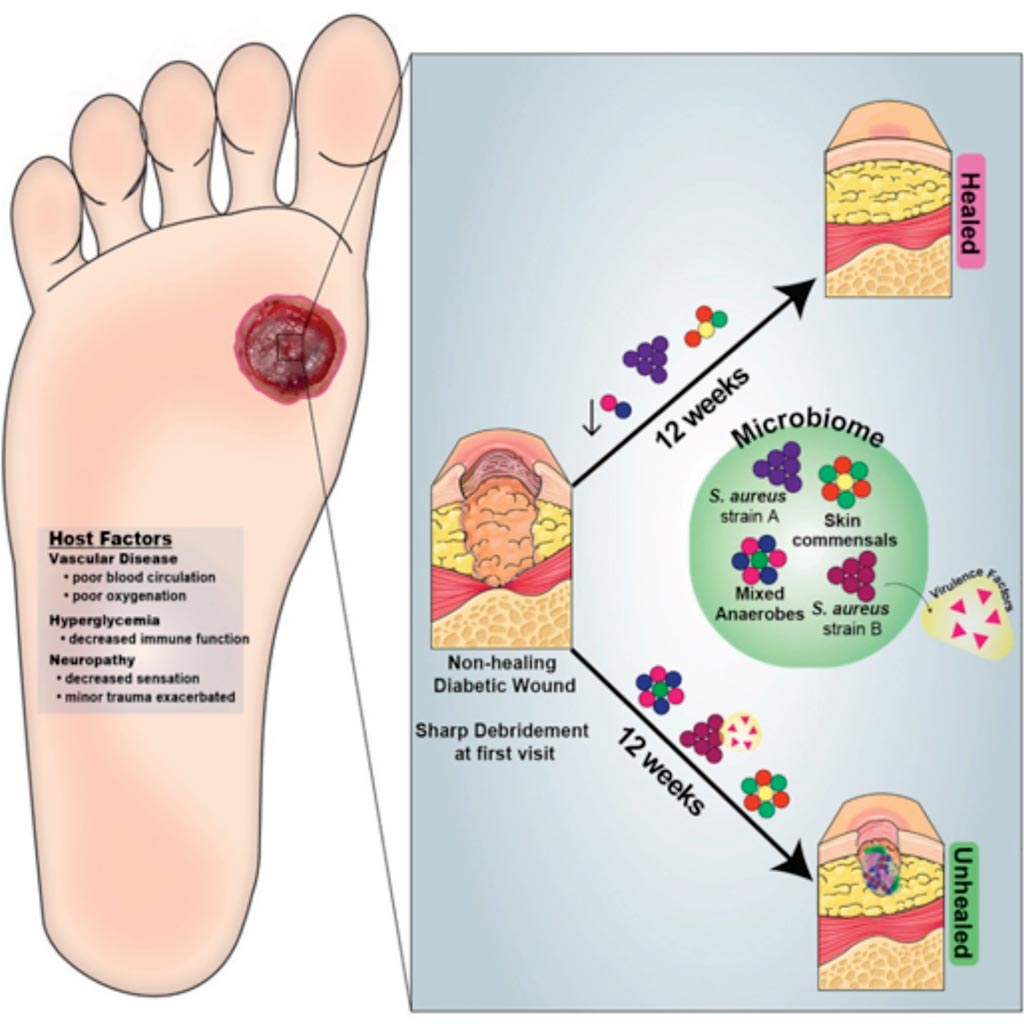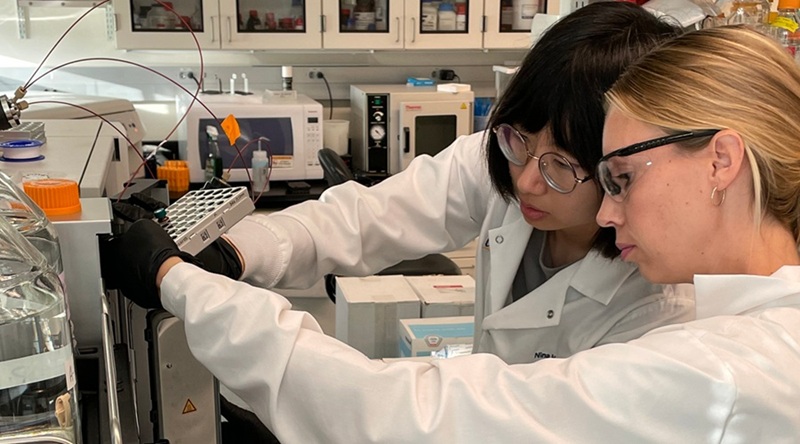Certain Bacteria Strains Associated with Diabetic Wounds
|
By LabMedica International staff writers Posted on 01 May 2019 |

Image: A graphic representation of Strain- and Species-Level Variation in the Microbiome of Diabetic Wounds Is Associated with Clinical Outcomes and Therapeutic Efficacy (Photo courtesy of the University of Pennsylvania).
About 10% of Americans have been diagnosed with diabetes, and one quarter of these patients will develop a wound that does not heal. In the worst case outcome, which occurs in up to 25% percent of these wound-developing patients, the wounds will require an amputation.
Many patients who develop these ulcers may not notice the initial signs, since the high blood glucose of diabetes can lead to a lack of feeling and deformation of the feet. As a result, patients with diabetes commonly develop foot ulcers that may go unnoticed over time. The mortality rate associated with diabetic foot ulcers is equivalent to that of breast cancer and prostate cancer combined, higher than 70% when they lead to amputation.
Scientists at the University of Pennsylvania School of Medicine (Philadelphia, PA, USA) and their colleagues investigated the role of colonizing microbiota in diabetic wound healing, clinical outcomes, and response to interventions, and conducted a longitudinal, prospective study of patients with neuropathic diabetic foot ulcers (DFU). Metagenomic shotgun sequencing revealed that strain-level variation of Staphylococcus aureus and genetic signatures of biofilm formation were associated with poor outcomes.
Cultured wound isolates of S. aureus elicited differential phenotypes in mouse models that corresponded with patient outcomes, while wound “bystanders” such as Corynebacterium striatum and Alcaligenes faecalis, typically considered commensals or contaminants, also significantly impacted wound severity and healing. Antibiotic resistance genes were widespread, and debridement, rather than antibiotic treatment, significantly shifted the DFU microbiota in patients with more favorable outcomes. These findings suggest that the DFU microbiota may be a marker for clinical outcomes and response to therapeutic interventions.
Elizabeth A. Grice, PhD, an associate professor of Dermatology and the lead author of the study, said, “While wounds don't receive the attention of other diseases, they're incredibly common, and our study increases our understanding of how microbes impair or promote healing. It is possible there are bacteria that actually benefit the wound, and we can use what we learned in this study to develop new treatment strategies for non-healing wounds. We hope this study will eventually help identify patients at risk for bad outcomes and lead to treatment innovations that these patients desperately need.” The study was published on April 18, 2019, in the journal Cell Host and Microbe.
Related Links:
University of Pennsylvania School of Medicine
Many patients who develop these ulcers may not notice the initial signs, since the high blood glucose of diabetes can lead to a lack of feeling and deformation of the feet. As a result, patients with diabetes commonly develop foot ulcers that may go unnoticed over time. The mortality rate associated with diabetic foot ulcers is equivalent to that of breast cancer and prostate cancer combined, higher than 70% when they lead to amputation.
Scientists at the University of Pennsylvania School of Medicine (Philadelphia, PA, USA) and their colleagues investigated the role of colonizing microbiota in diabetic wound healing, clinical outcomes, and response to interventions, and conducted a longitudinal, prospective study of patients with neuropathic diabetic foot ulcers (DFU). Metagenomic shotgun sequencing revealed that strain-level variation of Staphylococcus aureus and genetic signatures of biofilm formation were associated with poor outcomes.
Cultured wound isolates of S. aureus elicited differential phenotypes in mouse models that corresponded with patient outcomes, while wound “bystanders” such as Corynebacterium striatum and Alcaligenes faecalis, typically considered commensals or contaminants, also significantly impacted wound severity and healing. Antibiotic resistance genes were widespread, and debridement, rather than antibiotic treatment, significantly shifted the DFU microbiota in patients with more favorable outcomes. These findings suggest that the DFU microbiota may be a marker for clinical outcomes and response to therapeutic interventions.
Elizabeth A. Grice, PhD, an associate professor of Dermatology and the lead author of the study, said, “While wounds don't receive the attention of other diseases, they're incredibly common, and our study increases our understanding of how microbes impair or promote healing. It is possible there are bacteria that actually benefit the wound, and we can use what we learned in this study to develop new treatment strategies for non-healing wounds. We hope this study will eventually help identify patients at risk for bad outcomes and lead to treatment innovations that these patients desperately need.” The study was published on April 18, 2019, in the journal Cell Host and Microbe.
Related Links:
University of Pennsylvania School of Medicine
Latest Microbiology News
- Blood-Based Diagnostic Method Could Identify Pediatric LRTIs
- Rapid Diagnostic Test Matches Gold Standard for Sepsis Detection
- Rapid POC Tuberculosis Test Provides Results Within 15 Minutes
- Rapid Assay Identifies Bloodstream Infection Pathogens Directly from Patient Samples
- Blood-Based Molecular Signatures to Enable Rapid EPTB Diagnosis
- 15-Minute Blood Test Diagnoses Life-Threatening Infections in Children
- High-Throughput Enteric Panels Detect Multiple GI Bacterial Infections from Single Stool Swab Sample
- Fast Noninvasive Bedside Test Uses Sugar Fingerprint to Detect Fungal Infections
- Rapid Sepsis Diagnostic Device to Enable Personalized Critical Care for ICU Patients
- Microfluidic Platform Assesses Neutrophil Function in Sepsis Patients
- New Diagnostic Method Confirms Sepsis Infections Earlier
- New Markers Could Predict Risk of Severe Chlamydia Infection
- Portable Spectroscopy Rapidly and Noninvasively Detects Bacterial Species in Vaginal Fluid
- CRISPR-Based Saliva Test Detects Tuberculosis Directly from Sputum
- Urine-Based Assay Diagnoses Common Lung Infection in Immunocompromised People
- Saliva Test Detects Implant-Related Microbial Risks
Channels
Clinical Chemistry
view channel
Online Tool Detects Drug Exposure Directly from Patient Samples
Doctors often rely on patient interviews and medical records to determine what medications a person has taken, but this information is frequently incomplete. People may forget drugs they used, take over-the-counter... Read more
Chemical Imaging Probe Could Track and Treat Prostate Cancer
Prostate cancer remains a leading cause of illness and death among men, with many patients eventually developing resistance to standard hormone-blocking therapies. These drugs often lose effectiveness... Read moreMolecular Diagnostics
view channel
Ultrasensitive Method Detects Low-Frequency Cancer Mutations
Liquid biopsy has emerged as a promising approach for cancer detection and treatment monitoring, although its clinical impact has been limited by the extremely low levels of tumor-derived DNA circulating in blood.... Read more
Blood Test Enables Non-Invasive Endometriosis Detection
Endometriosis is a chronic, complex, yet relatively common gynecological disorder, reportedly affecting 1 in 10 adult and adolescent women. Endometriosis causes tissue similar to the lining of the uterus... Read moreHematology
view channel
MRD Tests Could Predict Survival in Leukemia Patients
Acute myeloid leukemia is an aggressive blood cancer that disrupts normal blood cell production and often relapses even after intensive treatment. Clinicians currently lack early, reliable markers to predict... Read more
Platelet Activity Blood Test in Middle Age Could Identify Early Alzheimer’s Risk
Early detection of Alzheimer’s disease remains one of the biggest unmet needs in neurology, particularly because the biological changes underlying the disorder begin decades before memory symptoms appear.... Read more
Microvesicles Measurement Could Detect Vascular Injury in Sickle Cell Disease Patients
Assessing disease severity in sickle cell disease (SCD) remains challenging, especially when trying to predict hemolysis, vascular injury, and risk of complications such as vaso-occlusive crises.... Read more
ADLM’s New Coagulation Testing Guidance to Improve Care for Patients on Blood Thinners
Direct oral anticoagulants (DOACs) are one of the most common types of blood thinners. Patients take them to prevent a host of complications that could arise from blood clotting, including stroke, deep... Read moreImmunology
view channel
Routine Blood Test Can Predict Who Benefits Most from CAR T-Cell Therapy
CAR T-cell therapy has transformed treatment for patients with relapsed or treatment-resistant non-Hodgkin lymphoma, but many patients eventually relapse despite an initial response. Clinicians currently... Read more
New Test Distinguishes Vaccine-Induced False Positives from Active HIV Infection
Since HIV was identified in 1983, more than 91 million people have contracted the virus, and over 44 million have died from related causes. Today, nearly 40 million individuals worldwide live with HIV-1,... Read more
Gene Signature Test Predicts Response to Key Breast Cancer Treatment
DK4/6 inhibitors paired with hormone therapy have become a cornerstone treatment for advanced HR+/HER2– breast cancer, slowing tumor growth by blocking key proteins that drive cell division.... Read more
Chip Captures Cancer Cells from Blood to Help Select Right Breast Cancer Treatment
Ductal carcinoma in situ (DCIS) accounts for about a quarter of all breast cancer cases and generally carries a good prognosis. This non-invasive form of the disease may or may not become life-threatening.... Read morePathology
view channel
Rapid Low-Cost Tests Can Prevent Child Deaths from Contaminated Medicinal Syrups
Medicinal syrups contaminated with toxic chemicals have caused the deaths of hundreds of children worldwide, exposing a critical gap in how these products are tested before reaching patients.... Read more
Tumor Signals in Saliva and Blood Enable Non-Invasive Monitoring of Head and Neck Cancer
Head and neck cancers are among the most aggressive malignancies worldwide, with nearly 900,000 new cases diagnosed each year. Monitoring these cancers for recurrence or relapse typically relies on tissue... Read more
Common Health Issues Can Influence New Blood Tests for Alzheimer’s Disease
Blood-based tests for Alzheimer’s disease are transforming diagnosis by offering a simpler alternative to spinal taps and brain imaging. However, many people evaluated at memory clinics also live with... Read more
Blood Test Formula Identifies Chronic Liver Disease Patients with Higher Cancer Risk
Chronic liver disease affects millions worldwide and can progress silently to hepatocellular carcinoma (HCC), one of the deadliest cancers globally. While surveillance guidelines exist for patients with... Read moreTechnology
view channel
Artificial Intelligence Model Could Accelerate Rare Disease Diagnosis
Identifying which genetic variants actually cause disease remains one of the biggest challenges in genomic medicine. Each person carries tens of thousands of DNA changes, yet only a few meaningfully alter... Read more
AI Saliva Sensor Enables Early Detection of Head and Neck Cancer
Early detection of head and neck cancer remains difficult because the disease produces few or no symptoms in its earliest stages, and lesions often lie deep within the head or neck, where biopsy or endoscopy... Read moreIndustry
view channel
Abbott Acquires Cancer-Screening Company Exact Sciences
Abbott (Abbott Park, IL, USA) has entered into a definitive agreement to acquire Exact Sciences (Madison, WI, USA), enabling it to enter and lead in fast-growing cancer diagnostics segments.... Read more



















